Every yogi knows the value of a high-quality yoga mat. Here are our recommendations for eco-friendly, non-toxic yoga mats that will take your practice to the next level!
Yoga isn’t just about becoming more flexible, strong, or fit. It also has a strong spiritual component. Yoga helps us focus on the present, reflect on ourselves, and meditate on our place in the universe.
It’s ironic then, that the very thing most people roll out to begin their practice – a brightly colored yoga mat – can harm the environment and their health.
To help you understand why traditional yoga mats are not sustainable, and what kind of yoga mat you should be looking for going forward, we’ve put together this guide to finding the perfect eco-friendly mat for your yoga practice.
Jump straight into our recommendations in the table below, or scroll down to read more about the various materials yoga mats are made of, and why you should make the switch to an environmentally-friendly yoga mat!
This article may contain compensated/affiliate links. See our full disclosure here.
Comparison of Eco-Friendly Yoga Mats
| Name | Type | Size (in) | Price | |
|---|---|---|---|---|
| Manduka eKo Yoga Mat | Natural Rubber | 71 x 24 | Check Here |
| Tiggar Yoga Mat | Natural Rubber | 72 x 24 | Check Price |
 | OKO Living Yoga Mat | Organic Cotton | 72 x 25 | Check Price |
 | Scoria Botanicals Mat | Cork & Natural Rubber | 74 x 24 | Check Price |
| Hautest Health Yoga Mat | Cork & Natural Rubber | 72 x 24 | Check Here |
 | Repose Yoga Mat | Cork & Natural Rubber | 72 x 24 | Check Here |
| Body by Yoga Mat | Cork & Natural Rubber | 80 x 26 | Check Here |
| Snakuga Yoga Mat | Cork & Natural Rubber | 72 x 26 | Check Here |
| Suga Yoga Mat | Recycled Wetsuits | 72 x 25 | Check Price |
| Live Well Yoga Mat | Organic Cotton | 78 x 27 | Check Price |
| Stag Sambu Mat | Sambu Grass | 72 x 24 | Check Price |
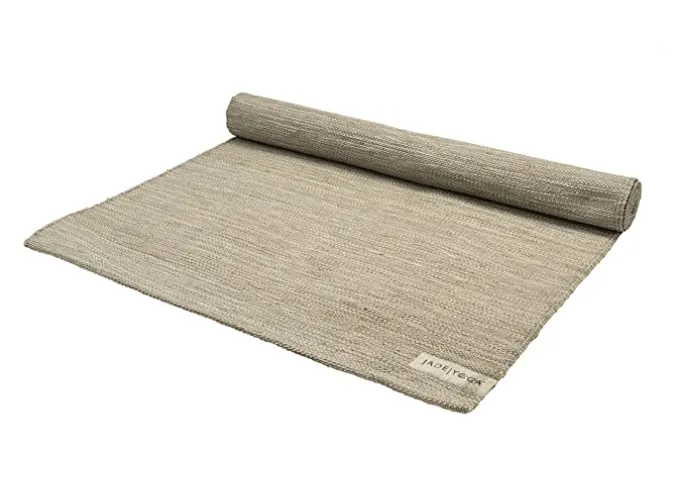 | JadeYoga Yoga Mat | Organic Cotton | 72 x 27 | Check Price |
What are typical yoga mats made of?
Yoga mats were designed to be sticky and cushiony, preventing slipping and adding a level of comfort.
In order to achieve this, companies turned to synthetic materials. Some of these synthetics claim to be environmentally friendly but beware of greenwashing – when it comes to how much less harmful they are, there are a lot of unknowns.
Let’s look at some of the more common yoga mat materials below. And why they’re not the best choice for a sustainable yoga mat.
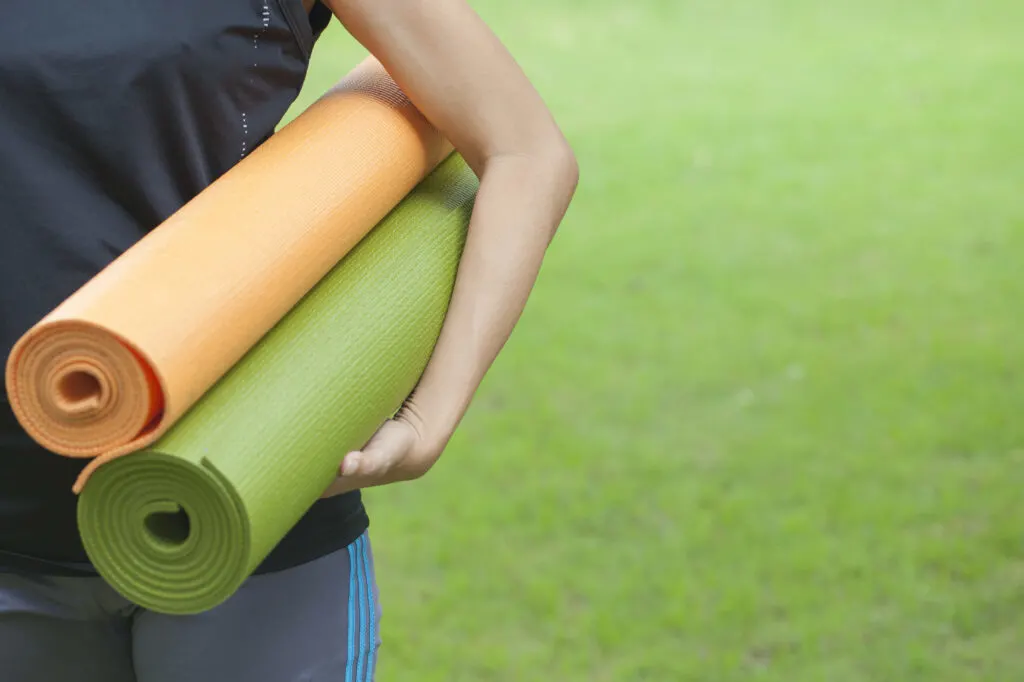
PVC Yoga Mats
PVC, or polyvinyl chloride, is a synthetic resin used to make everything from packaging to pipes. PVC yoga mats are made from PVC resin and anti-tearing fiber made into an open-cell (moisture absorbing) or closed-cell (moisture repelling) foam. The resulting mats have a desirable sticky quality.
PVC mats are hands down the worst for the environment. PVC requires a lot of water and petrochemicals to manufacture. Areas around factories are exposed to vinyl chloride, associated with increased cancer risks according to the National Institute of Health.
PVC contains phthalates, linked to both health and environmental impacts, in addition to other toxic additives.

It goes almost without saying that PVC is not biodegradable and nearly impossible to recycle. On top of this, disposing of it is hazardous. If it ends up in a landfill, it leeches toxic chemicals into the land. PVCs have even been banned from landfills in many European countries.
If burned, PVC generates a particularly hazardous gas due to its high concentration of chlorine. Far from being eco-friendly yoga mats, these are sadly still the cheapest and most prevalent.
TPE Yoga Mats
Thermoplastic elastomers (TPEs) are synthetic materials that are a mix of plastic and synthetic rubber. TPE is used to make closed-cell yoga mats, which are more hygienic and easier to clean.
TPE yoga mats were created as part of the quest for a more environmentally-friendly yoga mat, and they are branded as a safe choice. While they don’t contain phthalates, making them a better choice than some other materials, they still do contain plastic.
Since TPE has not been as widely studied as PVC, there are reasons to remain sceptical that TPE mats are completely non-toxic yoga mats.
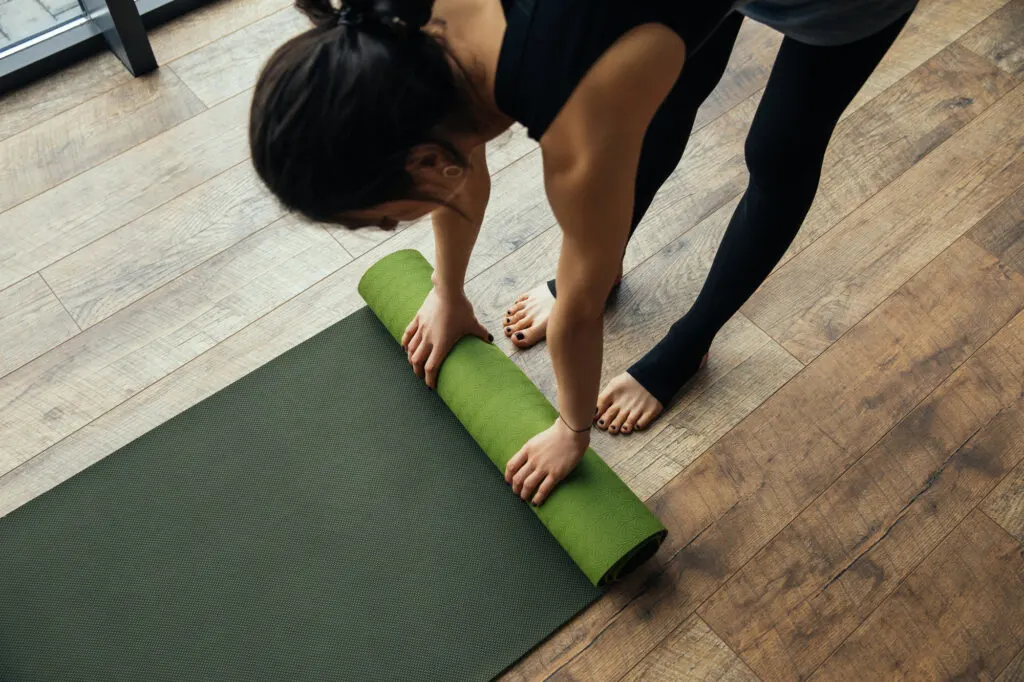
TPE is technically recyclable, but this doesn’t mean it’s easy to find a facility or company that will do this. TPE is also technically biodegradable, but being part plastic, it is not going to break down as fast organic materials.
If you’re looking for a truly zero waste yoga mat, you’ll need to look further.
PER Yoga Mats
Polymer Environmental Resin (PER) is another synthetic polymer. It’s plasticized in a way that makes it more biodegradable and less harmful to the environment. However, this still doesn’t mean that it will biodegrade quickly or completely harmlessly.
PER is touted as an eco yoga mat material, but there’s not a lot of research to back this up. Since this material is not yet as widely used and studied, it’s difficult to completely know its impact. For many, the simple fact that it is a kind of plastic is reason enough to avoid it.
Non-toxic Yoga Mat Materials
If you think you need a synthetic mat in order to practice yoga properly, think again. The practice of yoga is thought to be thousands of years old, so certainly there must be alternatives.
While some of these could have existed long ago, most utilize new technology to give their natural mats modern advantages.
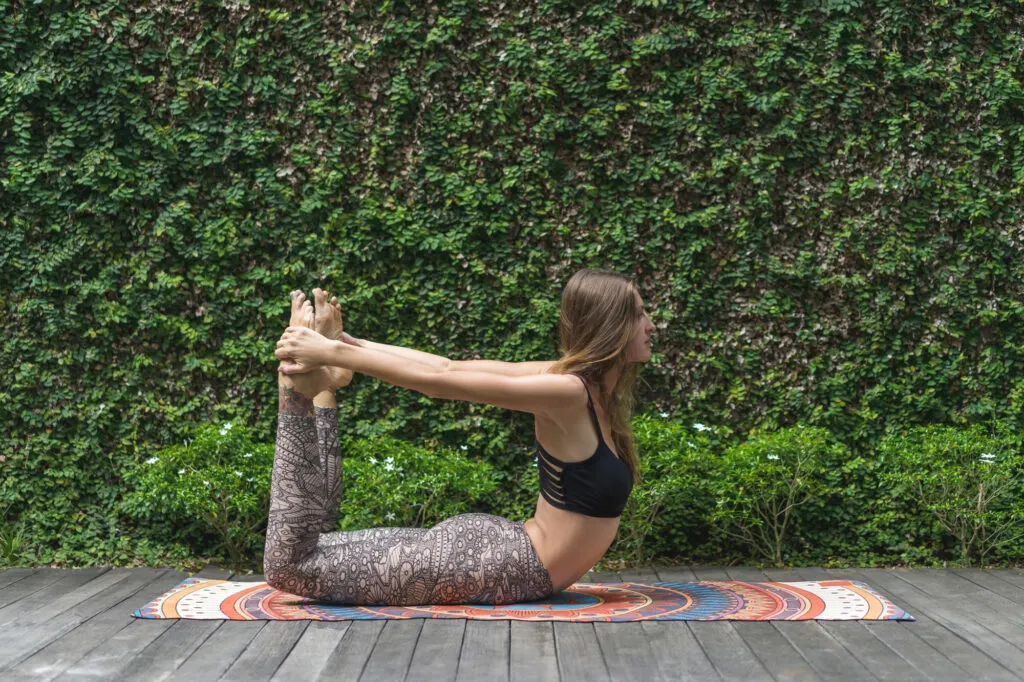
Natural Rubber Yoga Mats
Natural tree rubber yoga mats are sourced from rubber trees, which produce a milky-white sap that is harvested and then processed. Since rubber tapping does not require a tree to be cut down, it’s a sustainable practice, and rubber mats are made without any plasticizers or additives, making them biodegradable yoga mats.
In terms of performance, rubber offers grip, durability, cushioning, and both open-cell and closed-cell options, making for a great all-natural yoga mat.

On the downside, natural rubber has a smell that puts some people off. It will fade over time, however, and cleaning it with a 50/50 water-vinegar solution reportedly speeds up this process.
Rubber mats can also take a while to break in, and they are heavy, which is something to keep in mind if you plan on carrying it around, or traveling with it.
Best Natural Rubber Yoga Mats
Made from 100% natural tree rubber, the Manduka eKo Mat is a sustainable, biodegradable option. Soft and non-slip, it’s my personal go-to for both yoga and pilates, as I love the comfort and stability this mat provides.
Maduka also operates on a “zero waste” basis, using all scrap to create new products.
If you want to take your mat traveling often, have a look at the Manduka eKo Lite mat instead. While not very cushioning, it still provides an excellent non-slip surface and is foldable and lightweight.
A great budget option, the Tiggar Yoga Mat is also made from 100% natural tree rubber. At 4mm thick, it offers slightly less padding than the Manduka offering, but that may be a benefit depending on your preferences.
The Tiggar yoga mat comes in a variety of color options and has a lovely non-slip surface – especially good if you love hot yoga.
Cork Yoga Mats
Best known as the material of bottle stoppers, cork also makes a great eco yoga mat. Natural cork comes from the cork oak, which is grown in countries along the Mediterranean. Because only the outer layer of bark is stripped, cork is a very sustainable material that’s biodegradable too.
Cork contains a natural waxy substance that makes it water and rot-resistant. In a yoga mat, this provides a nice grip. Cork is also lightweight, so it’s perfect for people on the go.
Cork mats often have a cork surface and a natural rubber base, making them both comfortable and durable.

Cork mats require more care than synthetic yoga mats, and some have reported mats cracking when rolled up for long periods. Cork mats are also less cushiony and make a better fit for people who like a firm mat.
They are more expensive than their synthetic counterparts, but if you’re looking for a less smelly, chemical-free yoga mat, this might be the material for you. It’s especially good if you like to practice hot yoga due to the odor-free nature and water resistance.
Best Cork Yoga Mats
Sustainable yoga mat brand Scoria offers a range of cork yoga mats in fun prints (printed in non-toxic dyes).
The cork is sustainably harvested and backed with natural tree rubber. This is affixed with an eco-adhesive as opposed to glue.
The mats are antimicrobial, provide plenty of grip, and each mat purchased provides 10 meals to those in need through their partner charity, Feeding Children Everywhere.
Free of harmful chemicals, and made from eco-friendly materials such as cork and rubber, this yoga mat from Hautest Health is the perfect partner for your next yoga class.
This mat also comes with a lifetime guarantee, which is exceptional given the affordable price tag attached.
The Repose cork and natural rubber mat is both durable and portable thanks to the addition of a handy carry strap.
The non-slip surface means you won’t be sliding around during your yoga session, and the 4mm thickness strikes just the right balance.
The 100% natural construction is biodegradable and recyclable at end of life.
Luxury Yoga Mat by Body by Yoga
One of the best sustainable yoga mats for anyone who doesn’t want to compromise on comfort, this luxury yoga mat by Body by Yoga is both extra long and extra thick.
Made of premium Portuguese cork, and natural rubber, this premium mat is ideal for hot yoga, or anyone who sweats a lot during their practice too!
For a cork yoga mat that reflects your personality, choose this natural mat from Snakuga.
Laser engraved so as not to fade, the beautiful patterns on these mats are made to stand the test of time.
Made from natural cork, a premium natural rubber base, and zero glue, this sustainable yoga mat is 100% non-toxic.
Natural Textile Yoga Mats
Before synthetic mats, there were mats made of natural textiles. These days you can find zero waste yoga mats made from fibers like cotton, hemp, jute, and grasses. Hemp and jute are more sustainable materials to grow than cotton but less soft.
Sambu mats, made from a tropical grass grown in India that’s known for its cooling and air-filtering properties, may be an enticing choice for those looking for especially non-toxic yoga mats.

Natural textile options are biodegradable. Just make sure the materials are sustainably harvested or organically grown.
Natural textiles absorb sweat and provide some grip, but there’s a greater possibility of slipping. Fibers like jute and dharba also can be coarse against the skin, and these mats don’t provide the same level of cushioning as cork or rubber.
Best Natural Yoga Mats
Live Well Organic Cotton Yoga Mat
This natural yoga mat from Live Well is made of 100% organic cotton, so you can rest assured there are no nasties lurking here!
Cotton is naturally breathable and hygienic, making it an excellent choice for a yoga mat.
This one is handmade in India using Fair Trade labor, so you can also be assured you’re supporting an ethical brand.
Sambu straw is both cooling, and naturally non-slip, making it an excellent choice for a yoga mat.
This mat from Stag, is made from a combination of sambu and jute, making it robust, eco-friendly, and easy to care for.
This is one yoga mat you won’t need to put away after your practice as it looks great with your decor too!
Jade Yoga Organic Cotton Yoga Mat
If you’re looking for the ideal yoga mat to practice on the beach or outdoors, this organic cotton yoga mat from Jade Yoga is it!
Woven by artisans in India, this washable yoga mat is both lightweight and durable – making it an excellent partner for adventures!
Recycled Yoga Mats
Companies are starting to find innovative ways to repurpose old materials into new useful items such as yoga mats.
While prices vary, it’s possible to find a relatively affordable eco yoga mat in this category. Read the descriptions carefully, however, as many natural materials will also be mixed with TPE or PER.
Best Recycled Yoga Mat
For a yoga mat with a difference, try this revolutionary one from US brand Suga.
Made from recycled wetsuits, it’s thick, grippy, and dense at the same time. It won’t absorb sweat or bacteria, is easy to clean, and provides excellent cushioning. All while having a positive environmental impact!
The best eco-friendly yoga mat for you will depend on what kind of yoga you practice, your budget, and which factors you value the most. Luckily, the eco-conscious yoga community has created a demand for a variety of natural options, so as long as you stay away from three-lettered synthetics, you’re sure to find one that’s both sustainable and the perfect fit.
Pin this for later!
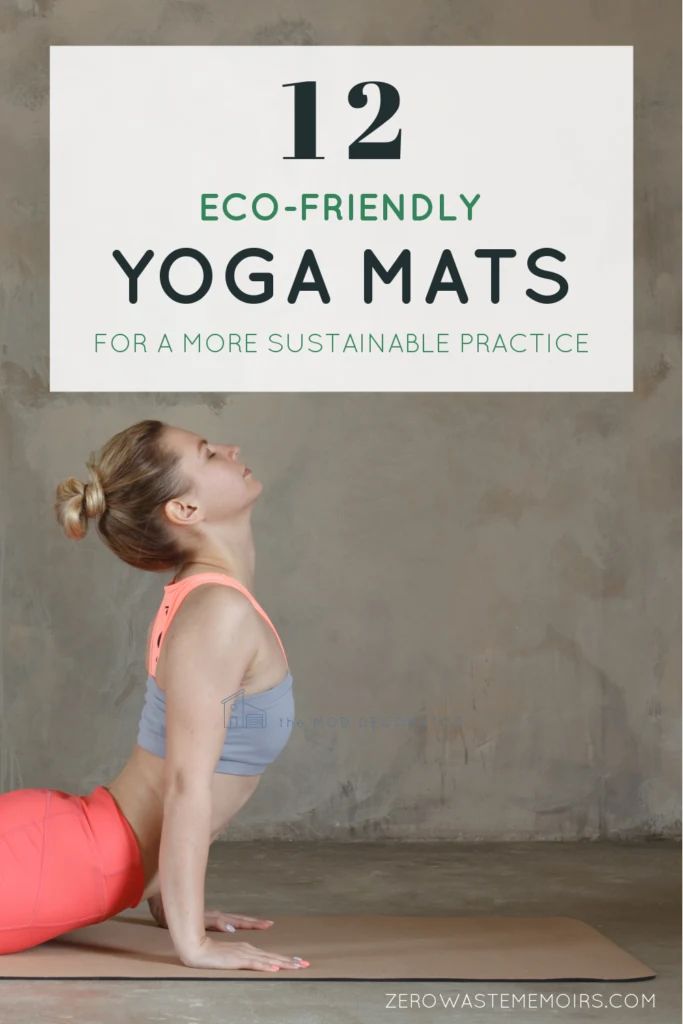










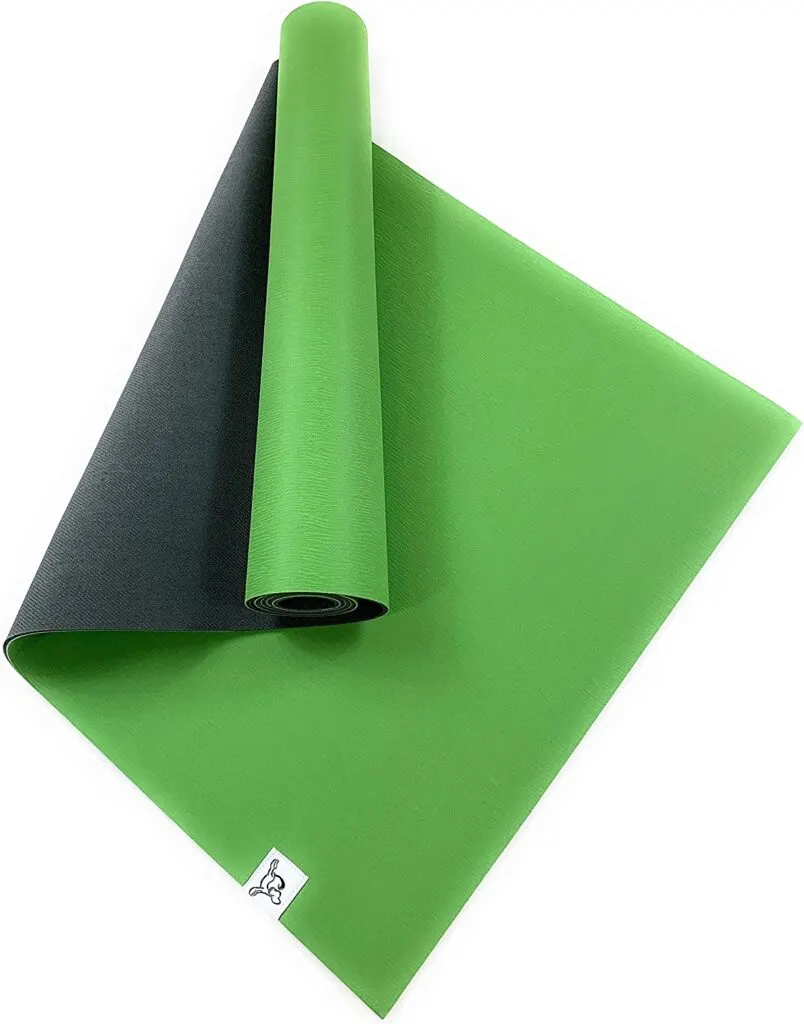

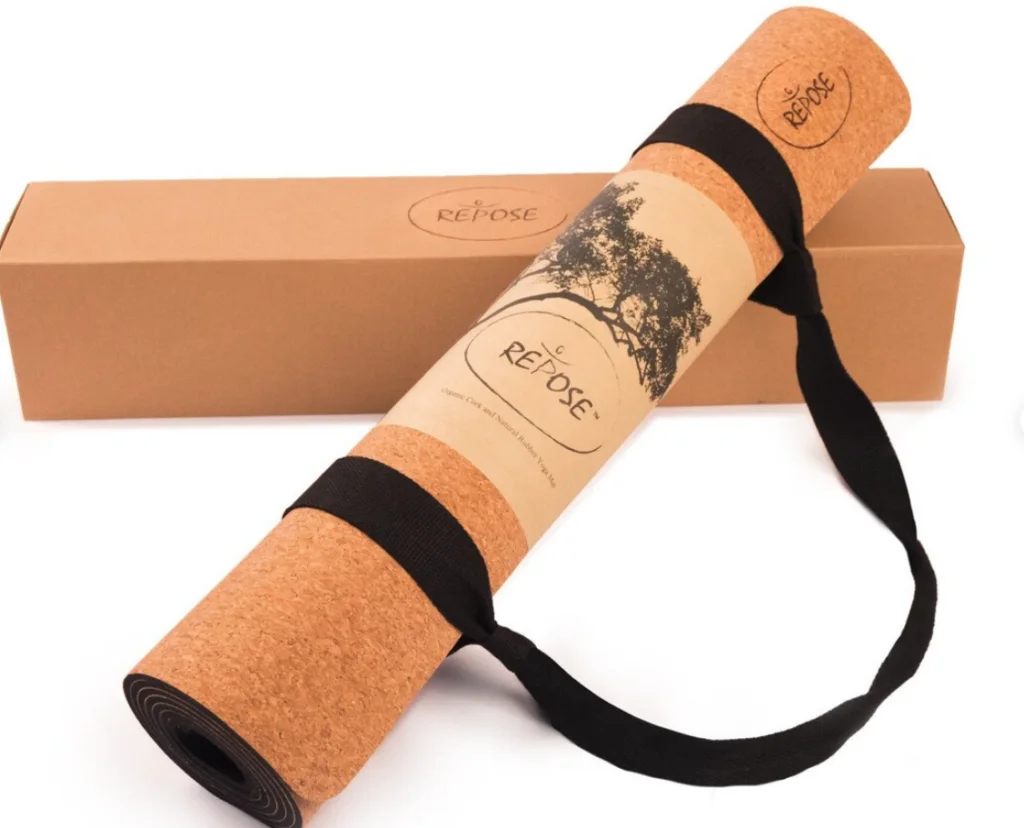






Reha Burrell
Wednesday 8th of April 2020
I'm 74 and need a thicker cushioned mat. I found one but the material used has off gassing that makes me sick. Do you have thicker mats?
Lauren
Thursday 9th of April 2020
Hi Reha, many of these brands offer thicker mats. I'd check their websites to see what they have that might suit you!
Shilpa
Thursday 28th of June 2018
Nice. These mats are made up of organic substances, so it is eco-friendly and good for health. Thank for sharing with us this wonderful post.
Danielle
Saturday 19th of August 2017
I am so happy to have come across this post! I cannot wait to purchase one of these. I too have been frustrated with mine and the thought of what it is made of. Thanks so much for bringing these brands to my attention as it has been one of the items that I have let slide!
Lauren
Wednesday 23rd of August 2017
Yay!!! This makes me so happy! Enjoy the hunt :)
Madalyn
Wednesday 19th of April 2017
Number one seems like the best quality to me and it's pretty!
Lauren
Sunday 23rd of April 2017
It's gorgeous isn't it?! It's close to the top of my wishlist right now ;)